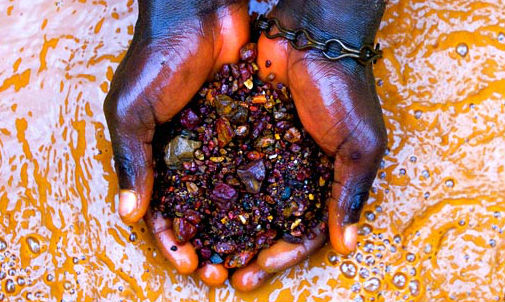Tanzania
Natural resources: coffee, tea, cotton, maize, tin, phosphates, iron ore, cassava, diamonds and gold. Its richness produces a gross domestic product valued at $33.23 billion. Ten percent of Africa’s gold is there.

Cote D’Ivoire
With abundant natural resources like coffee, cocoa, timber, maize, petroleum, rice, manganese and diamonds, this country’s GPD is $31.06 billion. Côte d’Ivoire is the second-largest economy in West Africa and is among the largest exporters of cocoa and cashew nuts, according to worldbank.org. The macroeconomic performance over the past two years is impressive, with a growth rate of around 8.7 percent. Inflation remains subdued at 2.5 percent.

Congo (Kinshasa)
Cassava, maize, coffee, rubber, copper, cobalt, zinc, gold, diamonds — all that is plentiful in this land with a GDP of $32.69 billion. Copper, in particular, is in abundance: 13 percent of all the copper in Africa.

Nambia
Millet, sorghum, diamonds, copper, uranium, gold. This country has reached an all-time high GPD of $13.11 billion, much of it because of the 46 percent of uranium it possesses on the continent.

Nigeria
Cocoa, groundnuts, palm oil, maize, sorghum, petroleum, tin, columbite, iron ore. The GDP in Nigeria reflects a country of vast wealth and resources: $1.058 trillion. Its crude steel production has increased significantly with a new plant that opened in 2006.

Morocco
Want wheat, barley, citrus, dates, phosphates, iron ore, manganese? They are here to the tune of $103.8 billion in GDP. Morocco is the leading African producer of primary refined lead, accounting for 88 percent of the continental output.

Ghana
With a GDP of 48.14 billion, this West African country boasts gold as its primary export, recently replacing cocoa. Diamonds, aluminum and bauxite also account for a large part of the country’s exports. This land accounts for 13 percent of Africa’s gold and 5 percent of its bauxite (for aluminum).

Kenya
Coffee, tea, maize, sugarcane, limestone, soda ash, rubies — they are all in Kenya, which has a GDP of $134.7 billion. Economic growth was at 4.9 percent in 2013 and 5.7 percent in 2014, according to africaneconomicoutlook.org.

South Africa
This beautiful land on the Atlantic Ocean is replete with maize, wheat, uranium, chromium, fruits, sugar, gold and diamonds. South Africa’s GDP is a hefty $683.1 billion. Twenty-one percent of the gold in the world is found in Africa, and an astounding 56 percent of the gold on the continent is in South Africa. Moreover, South Africa possesses 97 percent of Africa’s platinum.

Egypt
Egypt’s mineral and energy resources include petroleum, natural gas, phosphates, gold and iron ore. Crude oil is found primarily in the Gulf of Suez and in the Western Desert. Natural gas is found mainly in the Nile Delta, off the Mediterranean shore, and in the Western Desert. GDP: $945.4 billion. Thirty-two percent of Africa’s steel is produced in Egypt.

Tunisia
Edible resources like olives, dates, citrus and wheat are in abundance here, as well as petroleum, iron ore, phosphates. Tunisia has a GDP of $125.1 billion.

Angola
With a GDP of $175.5 billion, Angola is another agricultural country. Agriculture provides employment for 85 percent of Angola’s population. Oil production also contributes to Angola’s wealth, accounting for 45 percent of the country’s GDP. The country’s biggest natural resources are iron, petroleum and diamonds — Angola is the third-largest producer of the glittery gems.
source: atlantablackstar.com

One thought on “12 African Countries With the Most Diverse Natural Resources”